PPR (Polypropylene Random Copolymer) pipes have become a popular choice in modern plumbing and piping systems due to their durability, resistance to corrosion, and ability to withstand high temperatures. PPR Pipe are used for both residential and industrial applications, with fittings playing a crucial role in ensuring the efficient flow of fluids through the system. Among the most commonly used PPR fittings are elbows and tees. Although both serve to connect PPR pipes, they perform different functions and are designed for different purposes.
In this article, we will discuss the key differences between PPR pipe elbows and tees, exploring their structure, applications, and benefits, and help you understand how to choose the right fitting for your project.
What is PPR Pipe?
Before diving into the differences between PPR pipe elbow and tee, let’s first take a moment to understand what PPR pipes are and why they are widely used.
PPR pipes are made from a type of polypropylene, known as random copolymer, which is durable, lightweight, and resistant to heat and chemical corrosion. These pipes are commonly used in plumbing systems for both cold and hot water distribution, as well as for industrial and heating systems. PPR pipes come in various sizes and are connected using different types of fittings, including elbows and tees.
PPR Pipe Elbow: Definition and Applications
What is a PPR Pipe Elbow?
A PPR pipe elbow is a type of fitting designed to connect two pieces of PPR pipes and allow the flow of fluid at an angle. Elbows come in various angles, typically 45°, 90°, or 180°, depending on the specific requirement of the plumbing or piping system. The most common elbow is the 90° elbow, which allows the pipes to change direction at a right angle.
Types of PPR Pipe Elbows
- 90° Elbow: This is the most common type of elbow, used for making right-angle turns in the piping system. It is essential in situations where pipes need to be rerouted around obstacles or to change direction within confined spaces.
- 45° Elbow: This type of elbow is used when a pipe needs to change direction at a less sharp angle, often seen in cases where smoother flow of fluid is required.
- 180° Elbow: A 180° elbow is used to reverse the direction of the pipe completely, creating a U-shape.
Applications of PPR Pipe Elbows
PPR pipes elbows are widely used in a variety of applications, including:
- Plumbing systems: Connecting pipes in a home or building’s water supply system.
- HVAC systems: Directing airflow within heating, ventilation, and air conditioning systems.
- Industrial piping: Used in manufacturing processes where fluid flow needs to be diverted.
- Irrigation: Used in garden and agricultural systems for directing water flow.
Advantages of PPR Pipe Elbows
- Durability: PPR elbows are resistant to high temperatures, corrosion, and pressure, making them ideal for long-lasting applications.
- Easy Installation: These fittings are easy to install and require minimal maintenance, ensuring a hassle-free plumbing experience.
- Cost-effective: Compared to metal fittings, PPR elbows are more affordable while offering superior performance.
PPR Pipe Tee: Definition and Applications
What is a PPR Pipe Tee?
A PPR pipe tee is a fitting designed to connect three pieces of PPR pipe. It allows for a branch connection at a 90° angle to the main pipe. The name “tee” comes from its T-shape, where the main pipe is connecte to two branch pipes, creating a “T” structure.

Types of PPR Pipe Tees
- Equal Tee: This type of tee fitting has three equally sized openings, allowing for a branch pipe that is the same diameter as the main pipe. It is commonly use in systems where the flow needs to be equally distribute between the main and branch pipes.
- Reducing Tee: A reducing tee has a main pipe connection that is larger than the two branch pipe connections. This type of tee is use when the flow from the main pipe needs to be directe into smaller pipes.
- Straight Tee: A straight tee allows for a direct connection between pipes without altering the flow of water. It is typically used in simple plumbing systems.
Applications of PPR Pipe Tees
PPR pipes tees are essential for creating branch lines or splitting a single pipe into two separate flows. They are used in:
- Water distribution systems: Creating branch connections for water supply in buildings and infrastructure.
- Irrigation systems: Directing water from the main line to smaller branches for irrigation.
- Fire protection systems: Distributing water or fire-suppressing fluid to various sections of a fire protection system.
- Industrial systems: In systems requiring fluid distribution to multiple points.
Advantages of PPR Pipe Tees
- Versatility: PPR tees can be use in a variety of applications, including residential, commercial, and industrial systems.
- Durability: Like elbows, PPR tees are resistant to corrosion, high pressures, and chemicals, ensuring long-term performance.
- Efficiency: Tees help to divide the flow of fluid without causing significant pressure drops or blockages.
Key Differences Between PPR Pipe Elbow and Tee
While both PPR elbows and tees are essential fittings in plumbing systems, they serve distinct purposes. Here’s a summary of the key differences between these two types of fittings:
| Feature | PPR Pipe Elbow | PPR Pipe Tee |
|---|---|---|
| Function | Changes direction of flow in one pipe. | Connects three pipes, allowing branching. |
| Shape | Curved, typically 90° or 45°. | T-shaped, with three openings. |
| Number of Pipes Connected | Two pipes at an angle. | Three pipes, with a main pipe and two branches. |
| Applications | Used for bending pipes and changing directions. | Used to create branch connections or split the flow. |
| Flow Control | Does not split or redirect flow, only changes direction. | Divides the flow from the main pipe to two branch pipes. |
| Common Angles | 90°, 45°, 180°. | Typically 90°, but also can be straight or reducing. |
When to Use PPR Pipes Elbow vs. PPR Pipes Tee
- Use a PPR Elbow:
- When you need to change the direction of a pipe (typically 90° or 45°).
- When you are rerouting pipes around obstacles or need to redirect flow in a specific direction.
- When only two pipes need to be connecte, and there is no need for branching.
- Use a PPR Tee:
- When you need to split a flow into two or more pipes.
- When creating branch lines for water supply, irrigation, or HVAC systems.
- In systems where you need a T-shaped connection for distributing or receiving flow.
Conclusion
Both PPR pipes elbows and tees are essential components in modern plumbing and piping systems. Understanding the differences between these two types of fittings can help you make the right choice for your project. Elbows are ideal for changing the direction of pipes, while tees are perfect for branching out flow into multiple directions.
The right choice of fitting will depend on the specific needs of your piping system. Whether you are installing a plumbing system in a new building, upgrading existing piping, or working on an industrial project, ensuring you have the correct fittings is crucial for maintaining the efficiency and longevity of the system.
Frequently Asked Questions (FAQs)
1. What is the primary function of a PPR pipe elbow?
A PPR pipe elbow is use to change the direction of a pipe, typically at 90° or 45°, allowing for more flexible piping layouts.
2. How does a PPR pipe tee differ from an elbow?
A PPR pipe tee connects three pipes in a T-shape, allowing fluid to be diverte into branch pipes. An elbow, on the other hand, only changes the direction of a single pipe.
3. Can PPR elbows and tees be use in both residential and industrial applications?
Yes, PPR elbows and tees are versatile fittings that are suitable for both residential and industrial applications, such as plumbing, heating, and irrigation systems.
4. How do I install a PPR pipe elbow or tee?
Installation of PPR elbows and tees typically involves heat fusion or socket welding, where the fitting is heate and then attached to the pipe. It is recommende to follow manufacturer instructions for proper installation.
5. Are PPR elbows and tees resistant to corrosion?
Yes, PPR fittings are highly resistant to corrosion, which is one of the reasons they are so popular in plumbing and industrial piping systems.


















